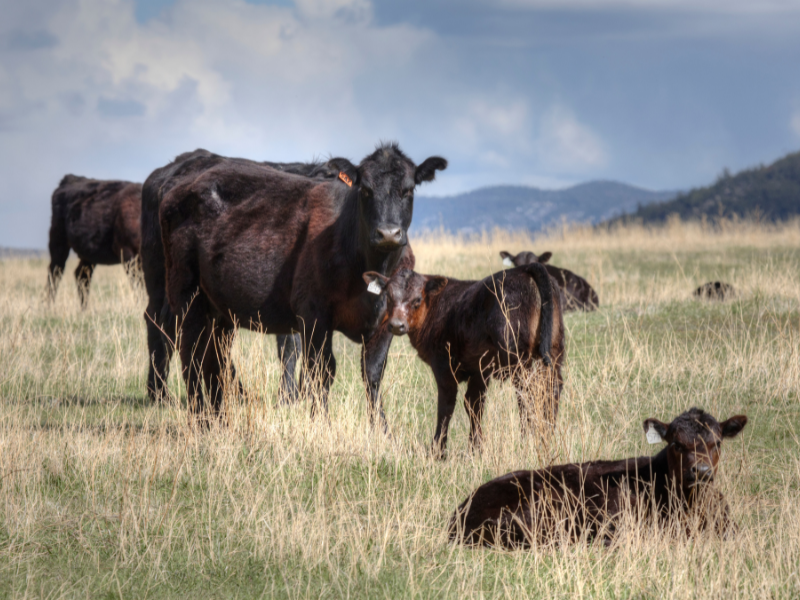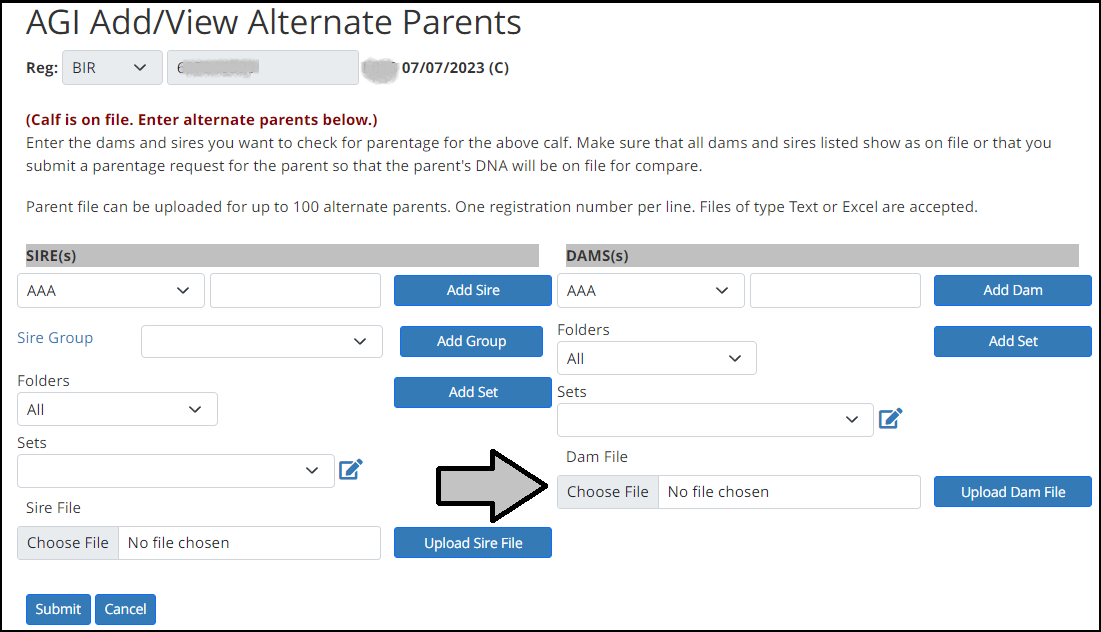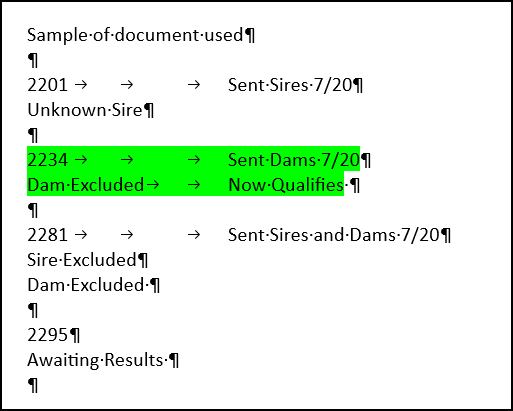Parentage Exclusions: Your Roadmap to Resolution
PARENTAGE EXCLUSIONS: YOUR ROADMAP TO RESOLUTION


It might seem like an unusual comparison, but I've started to see working with DNA Exclusions as akin to painting. Using a roller allows you to cover a large area efficiently, but when it comes to the finer details around windows, it requires a bit more time and practice, which eventually makes the process smoother.
Does your operation have an Embryo Transfer portion to it?
I begin by directing my attention to the ET (Embryo Transfer) calves. In situations where multiple donors were involved during that calving season, it raises the question of whether there might have been a mix-up with the embryos placed in the recipient cow, or if there could have been an error in recording which embryo went into which recipient.
I establish a text file and typically label it as "2023DonorsUsed.txt." Within this file, I record the registration numbers of all the donor dams utilized during the year. In a similar fashion, I create another file named "2023SiresForDonorsUsed.txt" to compile the information pertaining to the sires utilized in the embryo transfer procedures for the same period. This process ensures we maintain a systematic record of both donor dams and their corresponding sires for the year 2023.
Once you've dived into the results for a closer look, you can utilize the Edit Icon located within the Parentage column to add Alternate Parentage information. Upon opening this screen, you'll have the options to Upload Dam File and Upload Sire File. After selecting the respective file, click the corresponding Upload File button, and don't forget to repeat this process for the other file. There's no need to close out after completing the Donor Dam file and then return for the Sire file; you can efficiently handle both simultaneously. Just remember to scroll down and hit the submit button after adding both files to ensure the changes are saved.

The next file that I will create for the ET Calves that have a dam parentage exclusion is for any registered recipients. You can use the same interface to upload and test against any registered recipient cows.
Once the results are available, if the calf is a match to a recipient, it's likely a walking sire, so you should proceed to test against them as the clean-up sires as well. Additionally, follow up on any necessary adjustments to the ET status for the calf.
AI Sires versus Walking Sires
Typically, relying on pregnancy check data provides us with a high degree of certainty in distinguishing between the AI Sire and the walking sire used as part of the breeding program. What if you are using multiple clean up sires in the same pasture?
When dealing with scenarios involving multiple clean-up sires in the same pasture, consider utilizing the Sire Groups feature. You can access this feature by navigating to the My Herd tab, then selecting Animal Groups and finally Sire Groups.
Here's how to use it effectively: Create a sire group that includes both the AI Sires you used and the walking sires within the same group. When adding Alternate Parents using the same interface, use the Sire Group Drop Down and click the Add Group button to include the sire group.
By doing this, you can efficiently test against the entire Sire Battery in one go for any calves where there's a Sire Parentage Exclusion. This approach not only aids in identifying situations where a walking sire was used behind AI but also helps uncover potential errors, such as the use of the wrong straw on a female.

Unraveling the Mystery of Calf Swaps in Parentage Exclusions
I've come to realize that calf swaps occur more frequently than I initially anticipated. If you find that several dams have been excluded as parents, it's worth creating a file specifically for these excluded dams and conducting tests against the other dam exclusions. Especially when the calves share the same birth date, there's a strong likelihood that a calf swap could account for the parentage exclusions.
No SNP DNA on file to compare
If you find yourself in a situation where only one or two dams are exhibiting parentage exclusions, there's a possibility that a calf swap might have occurred involving a dam without DNA records. To begin an investigation into this possibility, you can isolate the excluded dams and test them against any calves for which the dam has no SNPs on file. If a match is found, the next step is to look at the calving records to find out whether the dam without DNA was present in the same location and calved on or around the same date, helping to determine if a calf swap indeed took place.
Organizing Alternate Parentage Submissions for Clarity
When you have just one or two exclusions, it's straightforward to stay organized and keep track of your alternate parent submissions. However, when you're dealing with a substantial number of exclusions, it's advisable to create a document for better management.
Maintain simplicity in this document. On the first line, I note the tattoo/tag of the animal with the issue, and underneath, outline whether you need to address the sire, dam, or both in certain cases. If there are cases still pending results, include those on the document as well. This approach serves as a helpful reminder for follow-up tasks and ensures you don't overlook any cases later on.
After I've submitted alternate parentage information for the animals in question, I make a note of the date when I sent these changes. When I return the following day, it becomes simpler for me to identify the cases that were submitted by referring to that date. If a match is confirmed at that point, I use a green color code to indicate that the animal has been cleared up.

DNA Tab > Test Results > Animals with excluded parentage
Make sure to explore the "Animals with Excluded Parentage" feature, accessible via the DNA Tab > Test Results > Animals with Excluded Parentage. If you've submitted multiple files throughout the calving season, your DNA Exclusions might be scattered across those files. Utilizing the "Animals with Excluded Parentage" option consolidates all these exclusions into a single result set. This approach simplifies the process, eliminating the need to toggle between different files while searching for exclusions.
I recommend keeping this list clean after each calving season. By this, I mean that if you encounter an exclusion that remains unresolved despite contacting AGI, and there are no further tests or qualifications to pursue, consider removing it from the list. A typical example might involve a neighbor's unregistered bull inadvertently got in with your cows during the breeding season. To do this, simply tick the box under the "Remove" column and click the "Remove Selected Rows" button.
More tips:
- After adding your alternate parents, be sure to proceed through the checkout procedure to signal AAA to begin their processing.
- Make it a practice to name your sire groups based on the year they were used, streamlining your access to them within the AAA Login platform.
- Handling a significant number of exclusions? Consider generating a Word document or Excel spreadsheet to assist you in monitoring the submission of alternate parents.
- Submitting your alternate parents by 3:30 PM CST is recommended. This timing typically ensures that you'll have access to the results the following morning.
- As results change, it's important to regularly review the birth/weaning contemporary group and make necessary adjustments. For instance, if there is a change from ET to Natural or vice versa, ensure that it's accurately reflected in the birth/weaning contemporary groups.
In conclusion, crafting a well-thought-out action plan for addressing parentage exclusions is crucial in maintaining the accuracy and integrity of your breeding program. By following the strategies and practices outlined in this article, you can navigate the challenges posed by parentage exclusions with confidence and efficiency.
Remember that while these situations can be complex, they are also opportunities to fine-tune your record-keeping, testing procedures, and overall herd management. Stay proactive, stay organized, and don't hesitate to seek assistance when needed.
